What is Holography
Holography is a technique that enables a wavefront to be recorded and later reconstructed. Holography is best known as a method of generating three-dimensional images, but it also has a wide range of other applications. In principle, it is possible to make a hologram for any type of wave. Gabor, who invented holography in 1947, introduced the term using two Greek words: “Holos” - whole and “Graphe” - writing. It simply means that the recorded holographic image of the object contains whole optical information about the object – Amplitude and Phase information of the light scattered from the object. Ideally, the hologram is a three-dimensional image reproduced from an interference pattern recorded by coherent light beans and holography is a process of reconstructing and writing a hologram.
White light from the sun or a light bulb is a combination of every color of light in the spectrum, which is not useful for a hologram. However, a laser shines light in a thin, intense beam that is of one color which implies that they are uniform and in-phase. When two laser beams interact, a single new wave pattern is produced: the hologram. Traditionally, holography was usually static and the application limited to displays, but with development in this science, it is used in various fields of applications, including art, security, data storage, and so on.
Difference between Holography and Photography
Holography may be better understood via an examination of its differences from
ordinary photography:
- Pattern Difference: Hologram produced by Holography is a positive pattern while conventional photography, a negative pattern is produced on the film.
- The Difference In Dimensions: Photography is the 2-D view of a 3-D object while in Holography, the viewer can see the image of the original object completely in 3-D form.
- What Part of the Image Is Constructed?: In photography, if a part of the image is destructed, there is the loss of information corresponding to that object. But the same does not happen in Holography as each part of the hologram contains information about the whole object.
- One Image Versus Many Images: Several images can be recorded on a hologram at the same time. But in photography, a single photo film cannot help in recording several images.
- Loss of Clarity: If a hologram is broken into pieces, each fragment is capable of producing a complete virtual image of an object with reduced clarity. But in photography, what is lost once is lost forever.
- Information Capacity: Holography has high information capacity as compared to photography.
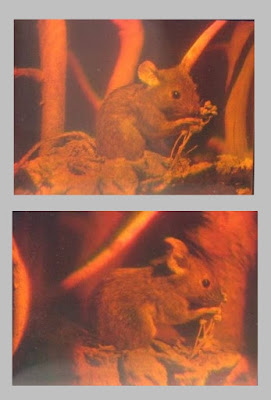 |
| Two photographs of a single hologram taken from different viewpoints (Image Source: Wikipedia) |
Working Process of Holography
A hologram is a recording in a two- or three-dimensional medium of the interference pattern formed when a point source of light (the reference beam) of fixed wavelength encounters light of the same fixed wavelength arriving from an object (the object beam).
Ordinary light is made up of many different wavelengths, none of which maintains a fixed phase relationship with each other or with themselves over a period of time. It has poor temporal coherence. Such incoherent light is not capable of interfering with itself, which is the most important for the application of holography. So lasers are used to produce light beams which are coherent over 1010wavelengths and more. The basic principle of holography general lies in two simple optical phenomena are interference and diffraction of light.
- Interference
- Diffraction
Interference
Interference is a phenomenon in which two waves superpose to form a resultant wave of greater, lower, or the same amplitude. Constructive and destructive interference result from the interaction of waves that are correlated or coherent with each other, either because they come from the same source or because they have the same or nearly the same frequency. Interference effects can be observed with all types of waves, for example, light, radio, acoustic, surface water waves, gravity waves, or matter waves. The resulting images or graphs are called interferograms.
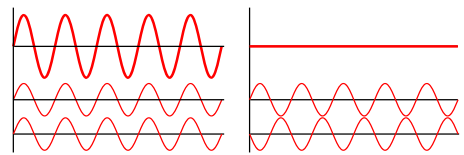 |
| Constructive and Destructive Interference pattern |
Diffraction
The phenomenon of bending of light waves around edges of small obstacles and hence its spreading into the geometrical shadow of the obstacle is called diffraction. The diffracting object or aperture effectively becomes a secondary source of the propagating wave.
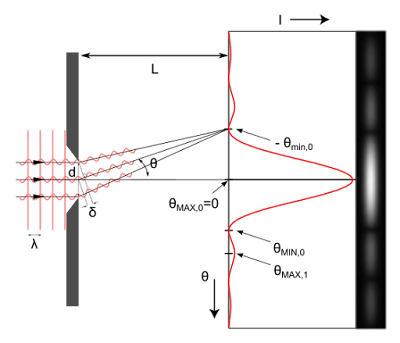 |
| Diffraction Pattern |
How to take a Hologram
Holography is a two steps process. In the first step, we capture the hologram ( i.e: an interference pattern of the object ) and the second step is the reconstruction of the image.
(a) Recording of the image
(b) Reconstruction of the image
Recording of the image or Hologram
Coherent light from a laser is directed on a Beam-Splitter. A Beam-Splitter divides the laser beam into two identical beams, which are aimed in two different directions. The two beams are the Object beam and the reference beam. The object beam is reflected by the surface of the object onto the plate. The reference beam directly falls onto the plate. So the laser beams interfere with each other. A laser light hologram is recorded.
To capture the three-dimensionality of an object, the film stores not only the amplitude but also the phase of the light rays. This recorded interference pattern actually contains much more information than a focused image and enables the viewer to view a true three-dimensional image that exhibits parallax.
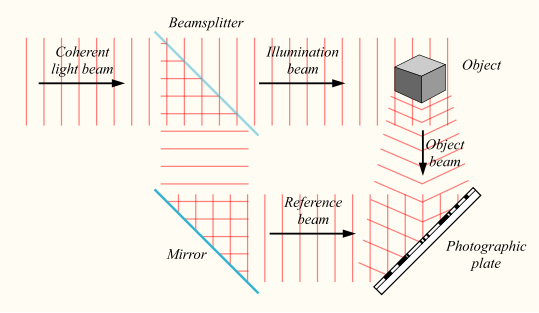 |
| Recording of Hologram (Source: Wikipedia) |
Hologram : 3d photograph
In holography a unique 3dimentional photographic image without the use of a lens. The photographic recording of the image is called a hologram, which appears to be an unrecognizable pattern of stripes and whorls but which—when illuminated by coherent light, as by a laser beam—organizes the light into a three-dimensional representation of the original object. An ordinary photographic image records the variations in the intensity of light reflected from an object, producing dark areas where less light is reflected and light areas where more light is reflected. Holography, however, records not only the intensity of the light but also its phase, or the degree to which the wavefronts making up the reflected light are in step with each other, or coherent. Ordinary light is incoherent—that is, the phase relationships between the multitude of waves in a beam are completely random; wavefronts of ordinary light waves are not in step.
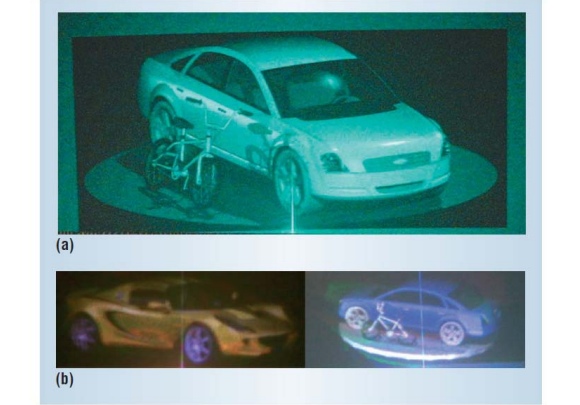 |
| Computer-generated hologram |
Reconstruction of Hologram
The laser light hologram can be reconstructed by using the same laser light as for recording. In the reconstruction of the hologram, the object beam and the reference beam strike the hologram plate from opposite sides. To prevent external light from interfering, holograms are usually taken in darkness, or in low-level light of a different color from the laser light used in making the hologram. Also, holography requires a specific exposure time, which can be controlled by electronically timing the laser.
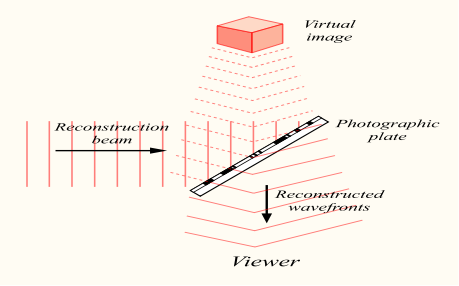 |
| Reconstruction of Image (Source: Wikipedia) |
Some applications of Holography
Holographic data storage
Holographic data storage is a technique that can store information at high density inside crystals
or photo-polymers. The ability to store large amounts of information in some kind of medium is
of great importance, as many electronic products incorporate storage devices. As current storage techniques such as Blu-ray Disc reach the limit of possible data density (due to the diffraction of the limited size of the writing beams), holographic storage has the potential to become the next generation of popular storage media. The advantage of this type of data storage is that the volume of the recording media is used instead of just the surface.
Holographic interferometry
Holographic interferometry (HI) is a technique that enables static and dynamic displacements of
objects with optically rough surfaces to be measured to optical interferometric precision (i.e. to
fractions of a wavelength of light). It can also be used to detect optical-path-length variations in
transparent media, which enables, for example, fluid flow to be visualized and analyzed. It can also be
used to generate contours representing the form of the surface or the isodose regions in radiation
dosimetry.
Sensors or Biosensors
The hologram is made with a modified material that interacts with certain molecules generating
a change in the fringe periodicity or refractive index, therefore, the color of the holographic
reflection.
Comments
Post a Comment